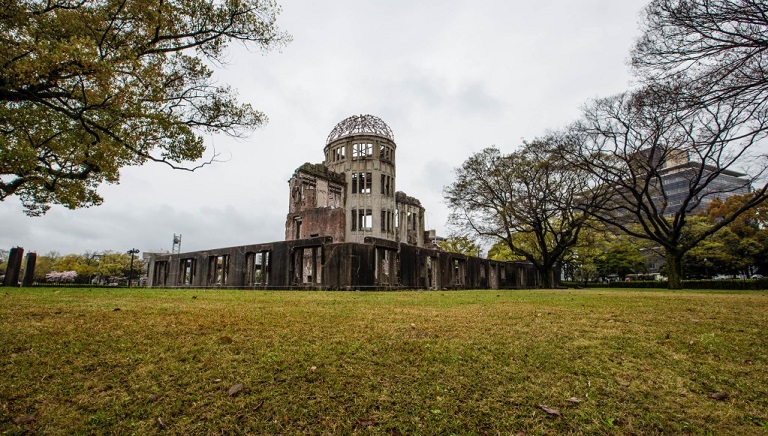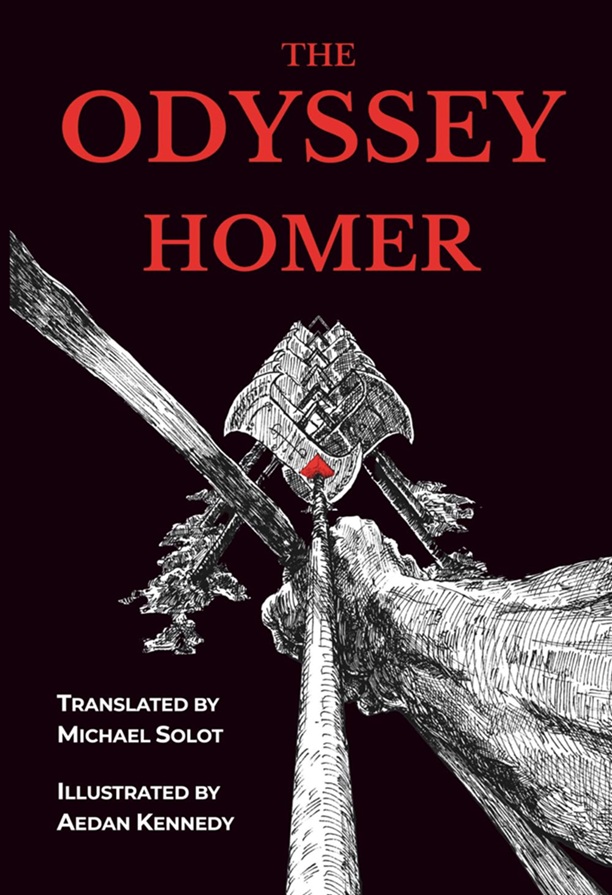.
The A-bomb Dome in Hiroshima
The epicentre of the blast was here,
This dome, its empty ribcage gaunt and bare,
It stands mute testimony to the day
A Superfortress, the Enola Gay,
Took to the cirrus-marbled cobalt skies
Above Hiroshima, unwished-for prize,
Its mission: razing of necessity
By nuclear fission an entire city.
Hiroshima rebuilt itself although
The marks of trauma long ago still show.
The dome aside, the tell-tale signs remain,
The oldest even now won’t let the strain
Subside from care-worn faces, cannot let
The vibrant world dismiss them or forget.
A wizened woman bent down to the ground,
She picked up in her fingers what she found,
An opalescent shard of broken glass.
She held it to the light, and made to pass
It to us while she uttered not a word,
And had we spoken she would not have heard,
Her mind elsewhere. Her friend then took her hand,
Led her away from us and we would stand
There motionless, our eyes would follow them,
As weary as are they whose years condemn.
They shuffled off, bent double as they went,
A railing for support. They both lament
Events of three score years and ten ago.
Forever fixed in minds the afterglow
Of unexampled horror won’t be shed
Till every last one yet alive is dead.
And yet how can we tell when that will be?
The living dead still walk among the free.
Their thoughts are not and never will be rid
Of memories of scorching flesh amid
The twisted girders and the molten glass,
The flowing tarmac and the noxious gas,
Of people torn to ribbons in the air,
The raining skies, the white blast and the glare
And then the blackness: nothing could compare
With this except in galaxies elsewhere.
That piece of broken glass: we had observed
Such fragments in the Peace Museum, preserved
In vials with their provenance, we read,
Removed from living beings and the dead,
From human skulls, from lungs and pancreas,
From livers slivers, splintered flakes of glass,
Extracted decades later from the bones
Of patients who complained of kidney stones.
Hibakusha: those still alive, old men,
Small children then who’d never play again,
And seventy years after the event
So many living then will still lament.
There was no other means, it seems, to end
The war and this the only way to send
A message to the whole world loud and clear
That nineteen forty-five was not a year
To celebrate VJ Day but to pray
Such desperate remedies have had their day,
That sabre-rattling need no more call
For acts of nuclear warfare but the fall
Of all dictatorships, the steady rise
Of stable government, for the demise
Of rogue states everywhere they flourish and
Prosperity for all in every land.
.
.
Peter Hartley is a retired painting restorer. He was born in Liverpool and lives in Manchester, UK.















Peter, this is an excellent poem, corresponding well to Evan’s selection of the most peaceful picture of the Dome that I’ve seen. The middle section of the poem, where the meeting with the two women takes place, followed by consideration of the pieces of glass, gives personal and social substance to the more general thoughts at the beginning and end. It’s a good division into easily readable portions. The poem as a whole is a good reminder of a terrible event that could easily be forgotten, as new threats and distractions develop. The rebuilding of Hiroshima, and the recent history of Japan, show that the peace and prosperity you imagine at the end of the poem are possible, even if in some way they must be fought for, defended, and freshly treasured, again and again.
Margaret – many thanks for your kind comment, and a very terrible and catastrophic event indeed it was, only mitigated by the knowledge that had it not happened the death toll would have been far greater still. I know you will have seen the A-bomb Dome in Hiroshima too, “preserved” in its ruinous state exactly as it was left on that bright hot August day in 1945. I don’t remember the lawn in front of it as it appears in Evan’s photograph. I just recall the modern buildings of a dynamic modern city surrounding it closely on all sides, and the slight unreasoning surprise I felt that nobody among all the office-workers who walked past it every day gave the building a second glance. I had intended the poem to be divided into three equal parts of five quatrains each for symmetry but it didn’t quite work out like that.
I agree with Margaret. This is very moving, and excellently written.
Thank you, Cynthia, for your comment. To see the Dome itself and to know it has been left exactly as it was in 1945 brings the horror instantly to mind.
Peter, I join with you in praying that “Such desperate remedies have had their day”. Your well written poem rightly covers the lingering effects of this human tragedy.
Thank you for your comment, David. The Peace Museum was opened in 1955 and since then has been, quite rightly, the most popular destination in Hiroshima for school trips from all over Japan, with over a million visitors per year. The catastrophe is unlikely ever to be forgotten.
Peter, as with all your poetry, this is beautifully written and laced with imagery. I love “Cirrus-marbled cobalt skies” and your depiction of the sad, shuffling, bent-double ladies is heartbreaking. The experience of visiting must have been so profound to inspire this most readable piece. Well done.
Jeff – Thank you for the kind comment. It was August 1993 when I visited Hiroshima, and my memory has played tricks on me in the interim. I recall buildings surrounding the A-Bomb Dome but Evan’s photograph shows open grass spaces all around it. I walked up Mount Fuji on that visit (without falling off it this time) and recall that one of the USA’s abandoned plans before dropping the bombs on Hiroshima and Nagasaki had been to blow the top off Mount Fuji before a select audience, to demonstrate the power of the atomic bomb without causing the immense loss of life.
Peter, this heart-touching, atmospheric, and informative poem brings with it a powerful message we should all look to. The majority of wars are nothing but money-making enterprises for fat-cat politicians. I’ll never forget Dr. David Kelly’s shocking end after bringing the truth to a nation duped by their government – his demise was not wasted on me. It opened my eyes, broadened my mind, and sent me in search of the truth. “The A-bomb Dome in Hiroshima” will serve to keep me on that path. Thank you!
Susan – And when money-making is not involved first-world countries steer clear of the problems of our third-world neighbours. We only have to look at the genocide in Rwanda and Burundi in the mid-nineties when western governments kept very quiet. Libya, Iraq and Kuwait, on the other hand, being full of oil, demand righteous interference on any pretext. Regarding Hiroshima, just seventy years after the event it is already difficult to determine how much specific warning Japan received before the bombs were dropped but the reason given for not blowing the top off Mount Fuji instead as a bloodless show of strength was fear that the bomb might have turned out to have been a dud.
Peter, as you have said you remember more buildings around the A-bomb dome, I will say that I do, as well. I believe I visited the area twice between 1985 and 1990, so you have been there more recently. The photo above is clearly taken from what I would call the rear, not from the busy riverside walk. I looked at many online images, obviously from different dates and different angles, and I am convinced that at least one large multistory building has been removed from the near vicinity of the dome. And when I look at a current map of the city, I see that the entire end of the port island where the dome building is located is now part of the Peace Park, which was not the case when I visited.
You are right to say that Japan remembers the bombing, and perhaps attaches even more importance to it as time passes. This could have led to an expansion of the park, with landowners willing to give or sell valuable port property for social and religious credit. The area has become a sacred space with heavy tourism, as you noted, and yearly ceremonies with vast numbers of people attending, often including members of the imperial family, powerful politicians, and famous peace activists from all over the world. I am not surprised at all this, recalling the Japanese care for special dates and places. It is much beyond what we English speakers usually do. And with 1945 now belonging to actual memory only among highly respected elders, the following generations owe a great deal of honor to them and to the deceased.
Margaret – Thank you for the assurance given in your words above that my mind has not been playing tricks on me over what I recall to have been the immediate environs of the A-Bomb Dome as I saw them in 1993. I can well imagine how more enlightened generations of city planners would have found the high-rise building that you speak of offensive and obtrusive to all who regard the Dome as a sacred place of pilgrimage and a reminder of the horror of 1945. We only have to look at any Japanese garden, as you know infinitely better than I, to see how important natural and manufactured horizons and vistas are as an aid to peaceful contemplation for the Japanese. To a more recent generation that high-rise block would have stuck out like a sore thumb, taking attention away from the Dome. “This dome, its empty ribcage, gaunt and bare” is what we have now, at a closer view as in Evan’s photograph, with nothing but the sky behind it on every side, exactly as it should be seen. I often think it a great pity that U.K. architects and the creators of flagrant outdoor “sculpture” today don’t give more consideration to the immediate context in which their monstrous carbuncles are going to be seen and loathed.